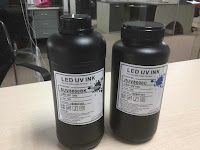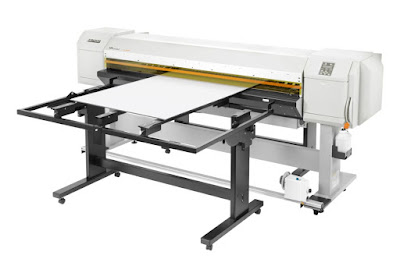1.What is UV printing exactly?
UV inks do not actually dry, they cure. The reason is quite simple: there is nothing in this inks to dry. Although they appear to be as liquid as any solvent-based ink, they are actually solids. They remain in liquid form however, until they come into contact with ultraviolet light. And then, they cure instantly. This ability has made large-scale screen printing operations competitive with other print technologies, and it's little wonder that this inks would come to dominate wherever production speed is critical. |
| UV Ink |
Another interesting feature of UV curing inks is that when they cure almost the entire ink deposit is transformed into a solid. In fact, the inks are 100% solids. As the solvents in a solvent-based ink evaporate, the ink deposit will continue to shrink until only the pigments and resins remain. But with this ink, everything you print onto substrate stays there.
2.How this inks work
The key to UV printing rests with inks that have been specially formulated to react to ultraviolet light. The terms UV,ultraviolet, and black light all refer to the same thing.Ultraviolet light is present in sunlight, although it is beyond the visible light spectrum. It's what your sunglasses and sun blockers are supposed to protect you from. Indeed UV-curable inks will react to sunlight, which is why you will never find a UV printing operation with an unfiltered skylight over the press. Like visible light, UV is a form of radiation and UV curing is lumped together with other forms of radiant curing like EB or electron beam curing.
Like conventional inks, it contain resins and pigments. But in place of solvents, they contain monomers and oligomers, small carbon-based molecules that have the capacity to form into long chains called polymers. If polymers are like a chain, then monomers (which provide the ink's adhesive properties) are like the links in that chain. To get them to start forming chains, It contain highly light-sensitive components called photo initiators. They are sometimes called photo-catalysts.
The curing process is called polymerization. Sometimes the term cross linking is used, which means that the monomers in one polymer chain begin linking to similar monomers in an adjacent chain to form a network. In the most common form of UV curing, (free-radical curing) this all happens very rapidly within seconds.
3.What are the advantages of using this ink?
 |
| UV Printing |
A second reason is that because of their rapid curing ability, this inks can increase production speed. Furthermore, a UV curing unit occupies less space than the drying racks or heating ovens used to dry solvent-based inks. Facilities that formerly operated heat dryers can also find their utility bills dropping. While UV curing units produce heat, it's nowhere near what a heat-drying unit creates.
Another big advantage of this inks is that they don't dry in the screen. Air-dry inks continue to increase in viscosity as you use them because the solvents in them continue to evaporate. the inks do not increase in viscosity. The result is you don't have to shut down in the middle of a production run to clean your screen. In some facilities using this inks, inks are left in the presses overnight.
Because of the fine meshes that can be used, this inks excel in printing fine four-color work and produce sharper prints. Many printers also combine this inks with solvent-based inks to take advantage of the benefits provided by both types. Needless to say, such combination jobs have to be approached cautiously and with careful testing to insure compatibility.
4.What are the disadvantages?
In the early years UV was associated with a strong and unpleasant odor. A lot of effort on the part of manufacturers has gone into reducing the odor with some success. There were also problems of the inks adhering to some substrates. And there are a number of areas where solvent-based inks simply perform better.A UV printing operation depends on its curing unit. If it fails, your production is completely shut down, so maintenance becomes a big issue. UV lamps have to be replaced after about 1,000 to 3,000 hours of use. And their output really should be monitored throughout their life cycle by regularly checking their output with a radiometer.
If you're thinking about converting to UV, be sure to budget for training employees to handle the new technology. It's quite a step for someone used to dealing with conventional inks. You should also expect to encounter a few failures as you mount the learning curve.
Health and safety concerns have to be addressed. Some people find the odor of UV curable inks unpleasant, so you may have to add some ventilation. It can cause skin irritation, and exposure to UV light can also cause a skin redness known as erythema. Needless to say, eye protection should be worn by anybody that might be exposed to UV light rays. UV shielding should always be in place on the curing unit.
Because of the heat generated in the curing unit, some heat-sensitive materials can only be printed with difficulty and great care.
Many of UV's problems date from the early days of the technology so be sure you have the most up-to-date information before making a decision about the process.
 |
| UV Printer |
All in all,UV inks are better for environment ,and they are more cheap than water-based and solvent-based inks,UV curing inks are still rising in use and will likely continue.
More Info:
Website: www.skyimagepaper.com
Company Name: Fei Yue Digital Technology Co.,LTD
E-mail: sales@feiyuepaper.com
Tel: 86-025-86628894
Whatsapp: +86 15007920742
Address: Central Road 323, Nanjing, Jiangsu, China
没有评论:
发表评论